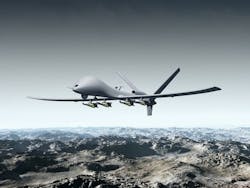Latest Mercury Systems embedded computing solution targeted at airborne intelligence, surveillance & reconnaissance, making ‘tactical cloud’ a reality
CHELMSFORD, Mass., 7 Oct. 2013. Mercury Systems Inc. (NASDAQ:MRCY), a provider of open sensor and big data processing systems for critical commercial, defense, and intelligence applications, is unveiling an OpenVPX-based sensor processing subsystem for an airborne intelligence, surveillance, and reconnaissance (ISR) application.
The new subsystem, based on the OpenVPX open architecture standard, can process and exploit large amounts of sensor data in real time, store it onboard for retrieval and forensic analysis, and send imagery to ground stations and handheld devices.
A combination of Intel Xeon server-class processors, general-purpose graphical processing units (GPGPUs), and ruggedized solid-state disk storage arrays form an open, commodity-class server capability for size, weight, and power (SWaP)-constrained airborne environments.
"Decision making requires information, and if you have to wait for it to be stored and analyzed on the ground, the time lost can be the difference between mission success and failure," says Ian Dunn, vice president and general manager of Mercury’s Embedded Multicomputing Group.
"Onboard processing and actionable intelligence dissemination are the logical and critical next steps in airborne ISR development, but deployment is slowed by the processing power available and the exponential growth of the data being collected. Our ability to deploy this subsystem--effectively a data center ‘server in the sky’--onto airborne pods and platforms is another example of Mercury’s continued leadership in OpenVPX,” Dunn says, adding, “these capabilities have truly opened up new horizons in airborne sensor processing for our customers."
Board-level fabrication and cooling technologies enable deployment of rugged, server-class compute power within harsh airborne environments, says a company representative. These technologies deliver 1-inch pitch OpenVPX modules that are cooled for full-throttle processing, addressing the onboard sensor processing challenge. Coupled with software tools for managing the convergence of data processing and information exploitation, these advances are enabling the defense industry to realize its goal of making the ‘tactical cloud" a reality for the warfighter, the representative continues.
Aircraft images courtesy of Shutterstock.
